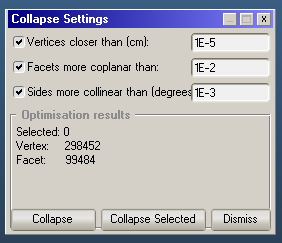
"Collapsing" a geometry means making a geometry use just as many facets as required and no more. This is very important since the time required to calculate a "hit" is proportional to the number of facets in the system (except if you use structures).
The usual way to get a geometry into Molflow is by importing a CAD file in STL format, which consists of triangles. That means that every vertex is created as many times as the number of facets that contain it.
Therefore, not only for speedup, but also for usability reasons, the first thing to do when opening an STL file is to collapse it.
Collapsing consists of three steps:
- Finding vertices that are at the same coordinate and merging them
- Finding facets that are
- Coplanar
- Adjacent to each other
- Have the same otugassing, temperature, etc. parameters
and merging them.
- Finding consecutive edges that are collinear, ie if a straight line is divided to 6 different sections and merging them.
Therefore you can toggle which of these steps you want to perform.
Vertices option
This is required to run at least one time, otherwise facet collapsing won't work.
It operates on all vertices of the geometry, regardless of the selection.
The tolerance value is the maximum distance in centimeters , within which two vertices are considered to be in the same coordinates.
Facets option
Each facet's plane can be defined by a Ax+By+Cz+D=0 equation. The tolerance value is the maximum coefficient difference within which two facets are considered coplanar.
Hint: to speed up collapsing large systems, select smaller part of the system, turn off vertex collapse (after it has run for at least once!) and use the Collapse Selected command. Since the collapse function compares ALL selected facets to ALL, dividing the system to 3 parts and collapsing by groups will be exactly 3 times faster than the Collapse All command. (1000*1000 comparison versus 3*333*333 in a 1000-facet system...) This is because you are helping Molflow to decide which facets are next to each other.
Collinear edges option
Since it is very fast, you can leave it on all the time. The tolerance value is in degrees, the maximum degree of turning under which two consecutive edges are considered collinear.